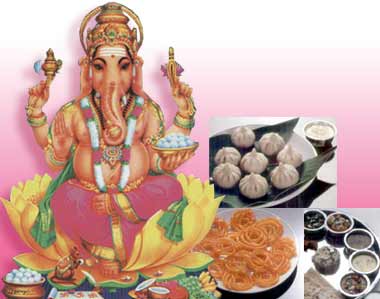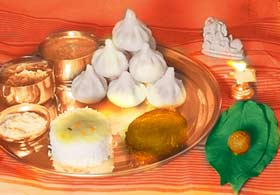|
|
| Help | |
| You are here: Rediff Home » India » Get Ahead » Leisure » Food |
|
| |||||||||||||||||||||||
|
| |||||||||||||||||||||||

 fter a long dreary spell of monsoon showers, Ganesh Chaturthi would arrive with a bright burst of colour. Days of driving rain had kept us indoors and we kids would be restless for some excitement.
fter a long dreary spell of monsoon showers, Ganesh Chaturthi would arrive with a bright burst of colour. Days of driving rain had kept us indoors and we kids would be restless for some excitement.
The first morning of Ganesh Puja was magical. When we awoke, Lord Ganpati would already be there, glowing from within his specially constructed temple, decorated beautifully with flowers and lights. The house would hum with activity as folks ran around getting the sweets and other samagrih (ingredients) ready for the first grand puja of this special season.
My great-grandfather had imperiously decreed umpteen years ago that each of his sons would, annually, honour a different god. My grandfather was chosen to honour Ganpati. So, for Ganpati Puja, all his brothers and their families would gather at his home where we lived as a joint family.
Incidentally my great-grandmother was dismayed when her eldest grandson, my father, married out of the community; their chief worry was who would bring the Elephant God home now.
The crotchety priest, who was preparing for the puja, always had numerous requests and the children were dispatched hither thither to gather sacred threads, an auspicious number of betel nuts, rice, oil... and steal a laddoo or two en route.
With great dhoom-dhaam (pomp), the puja would begin. Sweets of a mind-boggling variety, and an offering of Varan-bhaat (rice and lentils), would be set before the Lord.
Post-puja, 50-odd of us relatives would gather for a simple but festive meal. Thalis would be overloaded with Aamti (sweet and sour dal), Dal Wadi (cutlets made from a particular leaf), Varan-bhaat, Waal (sprouted lentils), Matki (seasoned sprouts), Polis (rotis), Raita, Chutney and Modaks (a steamed sweet that is said to be a favourite with Lord Ganesh).
AAMTI
(Sweet and sour lentils)
Ingredients
2 cups tuvar dal (yellow split lentils)
8 cups water
1 tsp haldi (turmeric)
2 tsp chilli powder
2 tsp imli paste (tamarind)
2 tbsp gur (jaggery)
1 tsp ghee (clarified butter)
2 tsp rai (mustard seeds)
2 tsp jeera (cumin seeds)
4 inches ginger, chopped fine
8 green chillies, chopped fine
2 tsp garam masala
Asafoetida
Salt
Fresh dhania (coriander), chopped fine
Method
Bring the dal to a boil. Mix in imli, gur, red chilli powder and haldi. Cook till dal is soft but not mushy. Keep aside. Heat the ghee till very hot. Add jeera seeds, then mustard seeds and asafoetida. Allow it to pop and brown slightly. Pour into the dal. Add coriander, garam masala, green chillies and ginger. Cook for a few minutes more. Your Aamti is ready to be served.
ALLU WADI
(Leaf-based cutlets)
Ingredients
3 large patra or allu leaves (available in most local markets)
1 cup besan (chick pea flour)
� tsp haldi (turmeric powder)
1 tbsp chilli powder
2 tsp garam masala
� tbsp imli (tamarind) paste
1 tbsp gur (jaggery)
Salt
Oil for frying
2 tbsp grated coconut
1 tsp til (sesame seeds), roasted
Fresh dhania (coriander), finely chopped
Method
Wash patra leaves. Dry well. Mix the besan, haldi, chilli powder, imli, jaggery, salt and garam masala and add water to make a thick paste. Spread this mixture evenly on one side of each patra leaf. Roll tightly and seal the ends with the paste. Do the same for the remaining leaves. Place the rolls in a pressure cooker and cook for 15 minutes. Allow them to cool. Cut into 1 cm slices. Heat the oil for tempering in a pan and shallow fry the slices. Garnish with coconut, dhania and til.
MIRCHICHA CHATKA
(Green chilli chutney)
Ingredients
� cup dahi (yoghurt)
4 green chillies
1 inch ginger, ground to a paste
Salt
Method
Roast the green chillies on a hot tava or griddle on high heat. Grind roughly. Add dahi, ginger paste and salt and serve.
MODAK
(Steamed sweet dumplings)
Ingredients
Filling
1 cup gur (jaggery)
2 cups freshly grated coconut
1 tsp rice flour
1 tsp poppy seeds, roasted
Seeds of 3-4 green cardamoms or elaichi, powdered
Cover
1 cup water
1 cup rice flour
1/2 tsp oil
1 tsp ghee
A pinch of salt
Method
Roast the jaggery and coconut in a small sauce pan or kadhai over low heat. Stir continuously until the jaggery melts and mixes well. Do not burn or overcook. Add poppy seeds, elaichi powder and rice flour. Continue cooking and mixing till the filling is mixed thoroughly. Keep aside.
Bring one 1 cup of water to a boil. Add salt, ghee, rice flour and oil. Mix well. Cover and cook for a few minutes, alternately stirring and then allowing it to simmer.
Turn the dough onto a flat surface or plate and knead while hot to make a soft dough. If it is too hot to handle, use a flat spatula to help the kneading process along.
Divide up the dough into 1-inch diameter balls. Roll the balls into circles that are 1.5 inches in diameter. In the centre, place a tablespoon of filling. Bring the edges of the circle together and squeeze shut so as to give it a slightly conical shape. Make a few pinches on the sides to give each modak a conical shape.
Repeat the process until you run out of filling or dough.
Line a flat-based colander with muslin cloth and carefully place the modaks inside. Place over a saucepan of boiling water. Cover and steam for 15 minutes. Alternately, use a pressure cooker. Open each modak slightly on top, garish the stuffing with ghee and serve piping hot.
Share your traditional Ganeshotsav recipes with rediff.com readers!
This article first appeared in India Abroad.
Image: Dominic Xavier
|
|
| © 2007 Rediff.com India Limited. All Rights Reserved. Disclaimer | Feedback |